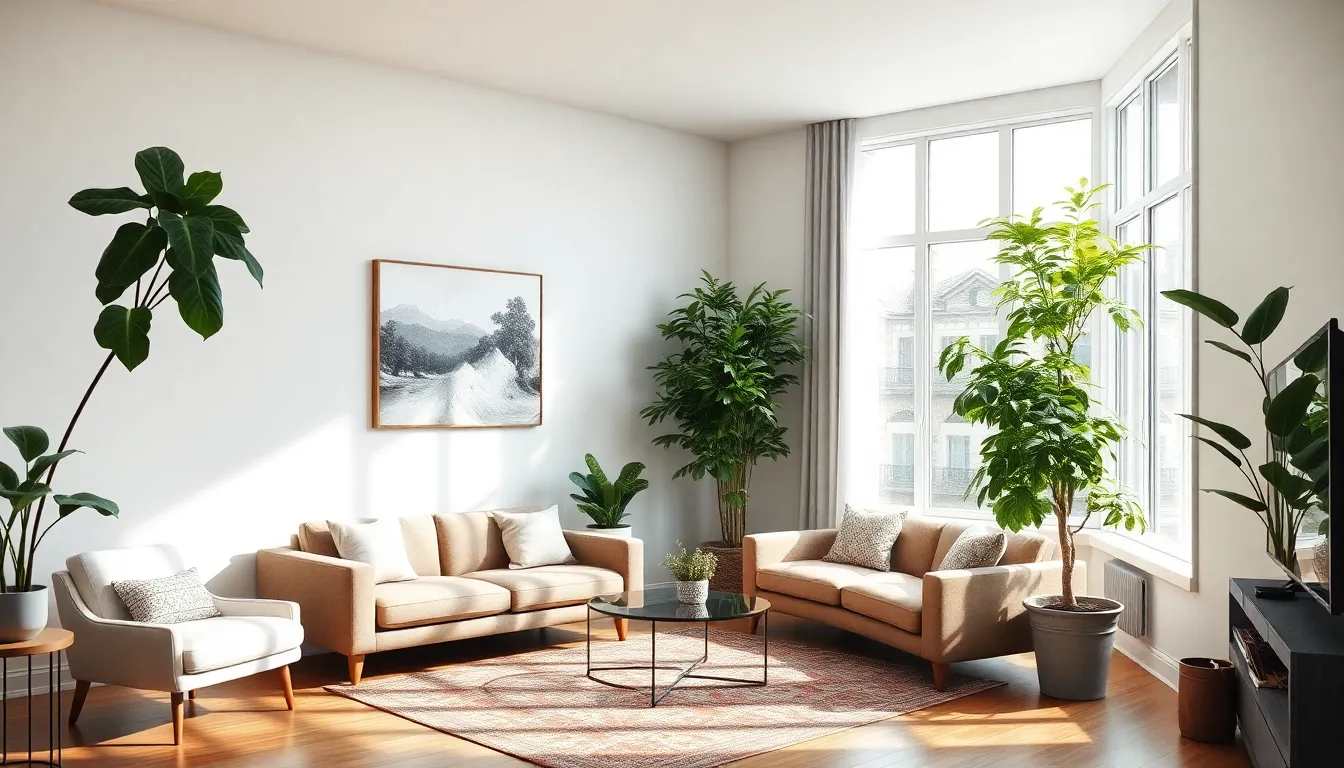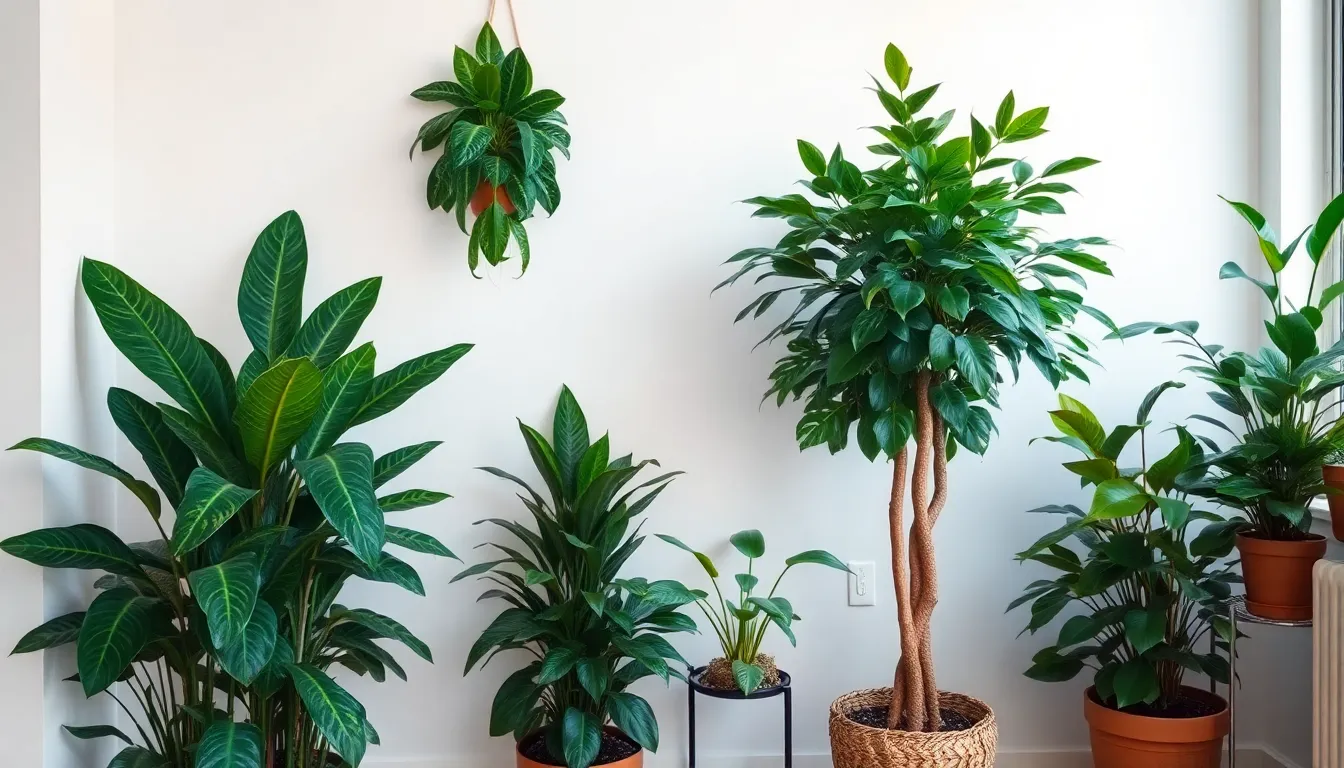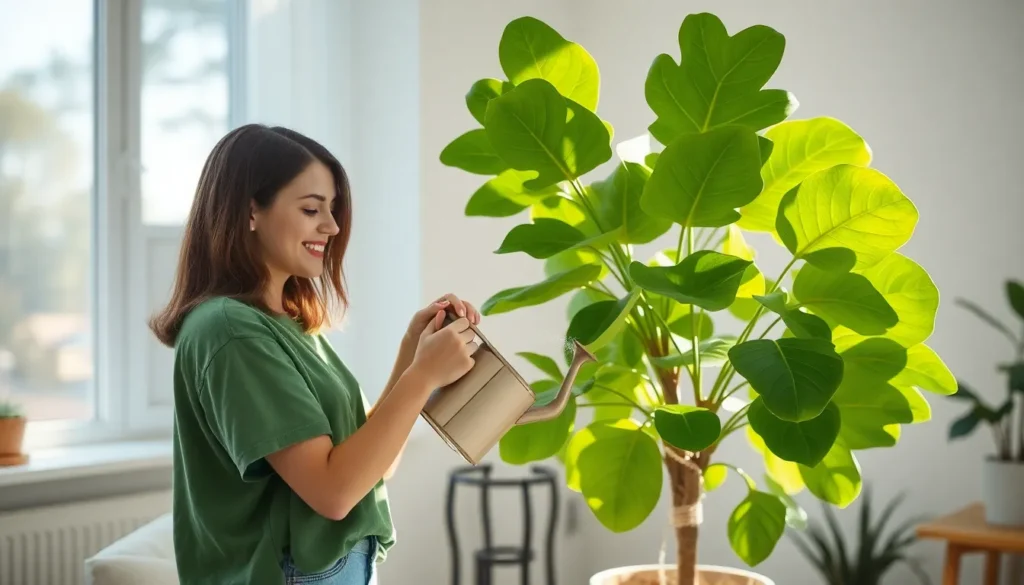Imagine transforming your living space into a lush oasis without ever stepping outside. Indoor trees are the unsung heroes of home decor, bringing the beauty of nature right into your living room. They don’t just sit there looking pretty; they purify the air, boost your mood, and even make your cat feel like a jungle explorer.
Table of Contents
ToggleOverview of Indoor Trees
Indoor trees contribute significantly to enhancing the atmosphere of living spaces. They serve various purposes, including improving air quality and boosting overall mood. Many people choose specific species for their unique benefits and aesthetic appeal.
Fiddle Leaf Fig, for instance, stands out due to its broad leaves and dramatic presence. Snake Plant, with its air-purifying qualities, thrives in low light, making it a popular choice. Additionally, Rubber Tree adjusts well to various environments and adds a touch of elegance.
Indoor trees also create a sense of tranquility and connection to nature. Studies indicate that interacting with plants can reduce stress levels. The presence of greenery stimulates positive emotions and makes rooms feel inviting.
Light requirements vary among different indoor tree species. Some thrive in bright, indirect light, while others tolerate low light situations. Regular watering schedules should adapt based on seasonal changes to maintain plant health.
Pets often benefit from indoor trees as they stimulate curiosity and provide exploration opportunities. Owners should select non-toxic varieties, ensuring pet safety while enjoying the beautiful homes filled with greenery. Common non-toxic options include Parlor Palm and Bamboo Palm.
Investing in indoor trees not only beautifies spaces but also cultivates a healthier living environment. Care and maintenance vary, yet the satisfaction derived from adding lush greenery is substantial. Each species presents unique characteristics that can cater to individual stylistic preferences and environmental conditions.
Benefits of Indoor Trees


Indoor trees provide numerous advantages for homes and environments. They enhance decor while offering practical benefits for inhabitants.
Air Quality Improvement
Indoor trees play a vital role in improving air quality. These plants absorb carbon dioxide and release oxygen, contributing to a fresher atmosphere. Certain species excel at filtering toxins from the air, making living spaces healthier. For instance, the Snake Plant is particularly effective at removing formaldehyde and benzene. Research indicates that having plants indoors reduces airborne pollutants significantly. Enhancing indoor air quality not only benefits physical health but also promotes overall well-being. Consequently, environments filled with indoor trees can lead to fewer respiratory issues and increased vitality.
Aesthetic Enhancement
Indoor trees significantly enhance the aesthetic appeal of any space. They introduce natural elements, creating a calming atmosphere conducive to relaxation. Varieties like the Fiddle Leaf Fig and Rubber Tree offer striking visuals with their unique foliage and sizes. Each tree serves as a statement piece, drawing attention and admiration. Moreover, incorporating greenery into interior design fosters a connection to nature, uplifting the spirits of inhabitants. Artfully placed indoor trees complement various decor styles, from modern to rustic. Thus, the inclusion of indoor trees transforms spaces into vibrant and inviting areas.
Popular Indoor Tree Varieties
Indoor trees offer a wide range of species, each providing unique aesthetics and benefits. Here are some popular varieties.
Fiddle Leaf Fig
Fiddle Leaf Figs stand out with broad, dramatic leaves that add visual interest to any room. These trees thrive in bright, indirect light, making them perfect for sunlit spaces. Regular watering keeps them healthy, though it’s essential to allow the top inch of soil to dry out between waterings. Known for their striking presence, they become focal points in decor. Choosing a Fiddle Leaf Fig enhances both the aesthetic appeal and mood of the environment.
Rubber Plant
Rubber Plants are admired for their glossy leaves and robust growth. They adapt well to various light conditions, from bright indirect light to low light. An ideal choice for beginners, they require infrequent watering—just once the soil feels dry. Their air-purifying capabilities further promote a healthier living space, absorbing toxins effectively. Incorporating a Rubber Plant provides elegance while supporting indoor air quality.
Areca Palm
Areca Palms add a tropical touch with their feathery, arching fronds. Preferring bright, indirect light, they thrive in well-drained soil with regular watering during growing seasons. This palm species excels at improving indoor air quality, removing harmful pollutants. They suit a variety of decor styles, bringing a sense of tranquility to any room. Selecting an Areca Palm enriches the living space while enhancing overall well-being.
Care and Maintenance
Maintaining indoor trees involves understanding their unique needs. Proper care ensures these plants thrive and enhance living spaces.
Light Requirements
Different indoor trees have varied light needs. Fiddle Leaf Figs prefer bright, indirect light, while Snake Plants can thrive in low-light conditions. Positioning the Rubber Plant near a window provides ample light, promoting healthy growth. Observing changes in foliage can help determine if light conditions are suitable. Yellowing leaves may indicate inadequate light, while leaf drop might signal too much direct sunlight.
Watering Practices
Regular watering helps maintain tree health. Typically, indoor trees require watering when the top inch of soil feels dry. Overwatering can lead to root rot, particularly in species like the Fiddle Leaf Fig. Adjusting frequency based on season is essential, as trees often need less water in winter. Using pots with drainage holes also prevents excess moisture buildup.
Fertilization Tips
Fertilizing indoor trees enhances growth and vitality. Applying a balanced, water-soluble fertilizer every four to six weeks during the growing season supports nutrient uptake. Rubber Trees respond well to fertilizers high in nitrogen, promoting lush leaf growth. Diluting fertilizer to half-strength can prevent root burn. Reducing or stopping fertilization in winter aligns with the plant’s dormant phase.
Common Issues and Solutions
Some common issues indoor trees face include pests, poor growth, and environmental stress. Pests like spider mites and aphids can infest trees, leading to yellowing leaves or stunted growth. Treat pests promptly with insecticidal soap or neem oil to prevent further damage.
Yellowing leaves often signal overwatering or poor drainage. If leaves turn yellow, check the soil moisture. When the top inch feels wet, it’s advisable to hold off on watering. Reevaluate the potting mix or drainage holes when drainage becomes an issue.
Environmental stress manifests through issues like browning leaf tips or leaf drop. Low humidity or excessive direct sunlight can contribute to these problems. Mist foliage or use a humidifier to boost humidity levels. Move the tree to a spot with filtered light if it receives harsh sun.
Nutrient deficiencies may affect overall tree health, causing slow growth or leaf discoloration. It’s essential to fertilize during the growing season with a balanced fertilizer. This practice supports robust growth and lush foliage.
Finally, repotting becomes necessary when roots outgrow their container. Signs include roots emerging from drainage holes or water pooling on top of the soil. Opt for a pot one size bigger and fresh potting mix for best results, ensuring roots receive adequate space.
Addressing these issues promptly contributes to healthy indoor trees, creating thriving green spaces within homes.

